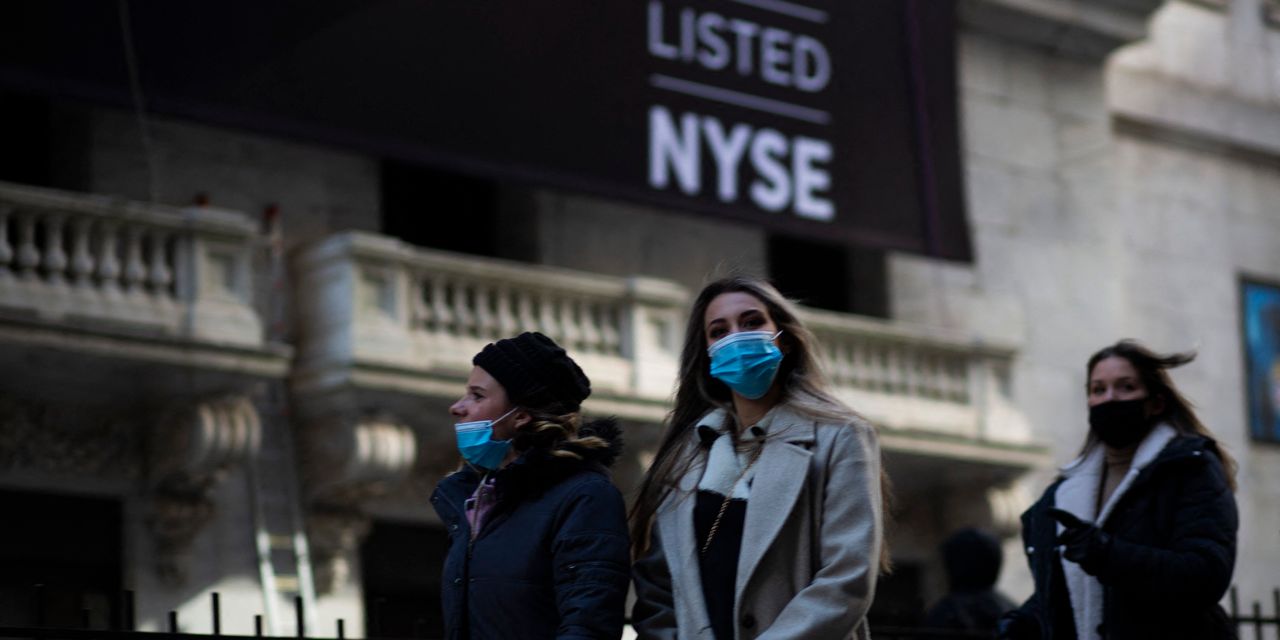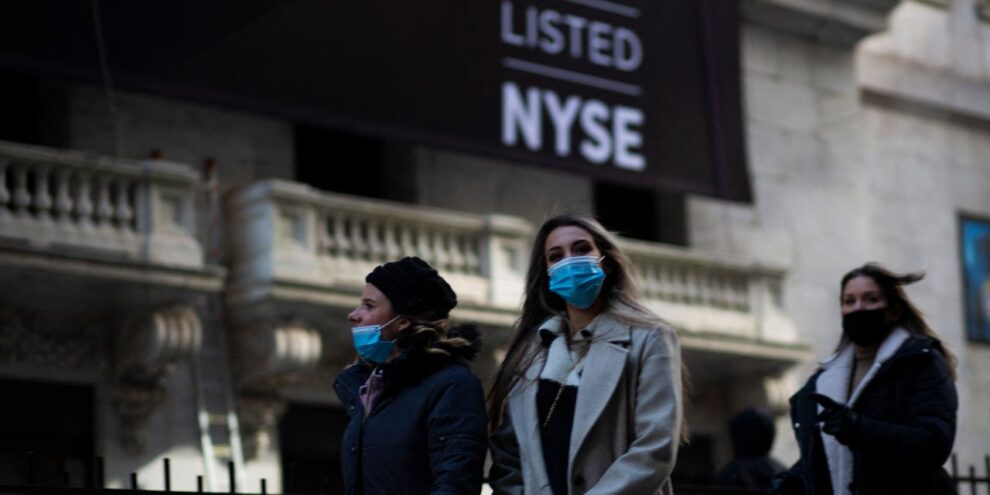
U.S. stock benchmarks were mostly lower Wednesday afternoon, after the Federal Reserve’s Beige Book survey showed only a modest uptick in economic activity to start the year, despite headway on the vaccination front.
Technology shares led equities lower, weighing down the S&P 500 index and Nasdaq Composite, as bond yields climbed and weaker-than-expected economic data also suggested a more tepid rebound from the COVID-19 pandemic.
How are stock benchmarks performing?
- The Dow Jones Industrial Average DJIA, -0.02% rose 98 points, or 0.3%, to about 31,488 at last check, after swinging between modest gains and losses.
- The S&P 500 index SPX, -0.96% was down 23 points, 0.6%, near 3,846.
- The Nasdaq Composite COMP, -2.34% slid 265 points, or 2%, to trade near 13,091.
On Tuesday, the Dow fell 143.99 points, or 0.5%, to 31,391.52, the S&P 500 slid 31.53 points, or 0.8%, to 3,870.29, while the Nasdaq Composite Index dropped 230.04 points, or 1.7%, to 13,358.79.
What’s driving the market?
Technology stocks were under pressure again Wednesday and weighing down the broader equities market, as economic data came in mixed and government bond yields climbed.
Climbing rates have been in the spotlight for several weeks, stoking fears of a potential policy misstep from the dovish U.S. central bank as it looks for the economy and job market to fully recover from the pandemic before tightening monetary conditions.
Chicago Federal Reserve President Charles Evans said Wednesday that rising interest rates at the short-end of the curve could be a problem, if it meant investors doubted the Fed’s commitment to get inflation higher, but also stressed that he won’t be getting nervous until inflation moves above a 2% annual rate, during a discussion sponsored by the CFA Society of Chicago.
High-growth tech darlings that could be vulnerable in a rising rate environment slumped, including Apple Inc. AAPL, -2.13%, Amazon.com, Inc. AMZN, -2.68% and Tesla Inc. TSLA, -4.06%.
“Everyone is watching the 10-year and 30-year Treasury yield,” said Robert Pavlik, a senior portfolio manager at Dakota Wealth Management, adding that rising yields have put pressure on technology stocks and more yield-sensitive stocks like utilities.
“It’s all about what central banks are doing and the amount of liquidity in the market,” he told MarketWatch. “Everyone is fearful of the rise in rates, even if that means a 10-year yield of 1.47%.”
Stocks initially struck an upbeat tone before the start of Wednesday trade, after President Joe Biden said late Tuesday that the U.S. would have enough COVID-19 vaccines for all Americans adults by the end of May, as he announced that the White House brokered a partnership between Merck & Co. MRK, +0.68%, and Johnson & Johnson JNJ, -1.53% to distribute J&J’s one-dose vaccination.
The seven-day average of COVID-19 vaccine doses administered in the U.S. recently hit 1.8 million a day, The Wall Street Journal reported, based on analysis of Centers for Disease Control and Prevention data. More than 50 million Americans have received at least one dose of a vaccine, representing about 15.3% of the population, according to the CDC. Meanwhile, the U.S. has averaged 65,468 cases a day in the past week, down 19% from two weeks ago.
However, Texas and Mississippi said that would they end mask mandates and reopen businesses, despite recommendations for caution from public-health professionals, including the CDC, which has warned against complacency.
Separately, Washington lawmakers planned to resume work on a further round of COVID aid as soon as Wednesday evening, with Democrats negotiating the terms of Biden’s $1.9 trillion relief package. That’s likely to add to the deluge of government bond issuance.
Investor anxieties have centered on moves in the bond market over the past two weeks, with attention trained on moves in the benchmark 10-year Treasury yield.
“The pace of the rise in interest rates was a bit worrisome,” said Will Geisdorf, senior research analyst with Sarasota, Florida-based Allegiant Private Advisors. “I think the market is still kind of digesting that.”
Right now, investors are most interested in the question of re-opening the economy, Geisdorf told MarketWatch. Any economic boost from more fiscal aid is already price into the market, he thinks, so the real question becomes, “how quickly do things open back up and how well do we suppress further spread?”
For now, Geisdorf thinks we’re in “a pause in the reflation trade. I think rates move higher and stocks can move higher with rates. That’s why you’ve seen the back and forth over the past few weeks.”
Federal Reserve Gov. Lael Brainard on Tuesday said that she wasn’t concerned about the move in yields, but noted that she was “paying close attention to market developments.”
Meanwhile in U.S. economic data, the U.S. economy expanded modestly over the six weeks ended in mid-February, according to the Federal Reserve’s Beige Book survey of current economic conditions. Business contacts were optimistic about the rest of the year as COVID-19 vaccines become available, but now, things were only getting better slowly, the survey showed.
ADP’s private-payroll data for February showed 117,000 jobs were created in the month, below the 225,000 forecast from economists polled by Dow Jones, and compared with a revised 195,000 in January. The ADP data come ahead of the more closely followed nonfarm-payrolls report due on Friday from the U.S. Labor Department.
The IHS Markit US services sector purchasing managers index rose to 59.8 in February, up from 58.3 in January and above the earlier ‘flash’ figure of 58.9. However, the Institute of Supply Management non-manufacturing sector index fell to 55.3 from 58.7.
Which stocks are in focus?
- General Electric Co. GE, +4.01% shares were up 4.6% near a three-year high Wednesday, after UBS analyst Markus Mittermaier said rising interest rates and the COVID-relief bill are reasons to get a little more bullish on the industrial conglomerate.
- Shares of Las Vegas Sands Corp. LVS, +0.95% rallied 1.7% Wednesday, after the casino operator announced agreements to sell its Las Vegas property and operations for $6.25 billion to Apollo Global Management APO and VICI Properties Inc. VICI.
- Oscar Health OSCR, -9.92% shares stumbled out of the gate Wednesday and were down 8.4% in afternoon trade. Co-Founder Joshua Kushner, the brother of Jared Kushner, the son-in-law of former President Donald Trump, will have 75% control of the company.
- FedEx Corp. FDX, +0.32% said Wednesday it will invest $2 billion in its commitment to be carbon neutral by 2040. As part of the plan, the package delivery giant said it entire fleet of pickup and delivery (PUD) fleet will be electric vehicles by 2040.
- Shares of fuboTV Inc. FUBO, -17.88% slid 18% after the live-sports streaming service reported spikes in quarterly revenue and subscribers.
- Boston Scientific Corp. BSX, +0.32% announced Wednesday an agreement to buy the global surgical business of Lumenis LTD for $1.07 billion in cash from Baring Private Equity Asia. Shares were 0.5% higher.
- Cannabis accessories maker Greenlane Holdings Inc. GNLN, -4.90% said Wednesday it has acquired the specialty silicone smoking products Eyce brand and most of its assets in a deal it said would immediately boost earnings.
How are other assets faring?
- Bond yields rose on Wednesday after the European Central Bank declined to take action to rein in bond yields. The yield on the 10-year Treasury note TMUBMUSD10Y added 6 basis points to 1.47%. Yields and bond prices move in opposite directions.
- The dollar gained 0.1%, as measured by the ICE U.S. Dollar Index DXY, +0.15%.
- Oil futures closed higher on talk of a potential OPEC+ rollover of production cuts, with the U.S. benchmark CL.1 up $1.53, or 2.6%, settling at $61.28 a barrel, as the commodity attempts to erase Tuesday’s losses. Gold futures GC00 declined 1%, or $17.80, to settle at a 9-month low of $1,715.80 an ounce, as the precious metal resumed a downtrend.
- Equities edged higher in Europe, with the pan-European Stoxx 600 index SXXP up 0.1% and London’s FTSE 100 UKX gaining 0.9%.
- Stocks surged in Asia: The Shanghai Composite SHCOMP jumped 2% and Hong Kong’s Hang Seng Index HSI rallied by 2.7%, and China’s CSI 300 000300, +1.92% gained 1.9%, while Japan’s Nikkei 225 NIK rose 0.5%.






